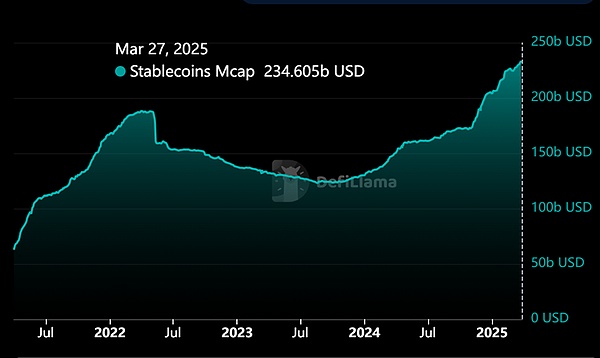
Source: Blockchain Knight
According to data statistics from DefiLlama, the market value of stablecoins hit a record high last week, with a total market value exceeding US$234.6 billion, which has almost doubled compared to US$124 billion at the low of August 2023. Currently, USDT still leads the stablecoin market with a market share of more than 62%.
At the same time, Crypto's total market value has almost experienced market value changes similar to the stablecoin trend in the past two years, doubling from about US$2 trillion in mid-2023 to about US$4 trillion, but the highest point occurred in December last year, and it has fallen back to around 2.8 trillion, a drop of about 30%, diverging from the growth of the stablecoin's market value.
So an interesting question arises: Why is the market value of stablecoins growing, but the total market value of the Crypto market continues to decline?
From the following figure, the change chart of the total market value of stablecoins and BTC market value, it can be seen that before December last year, the trend changes of the two were almost the same. The rise of BTC is often accompanied by the rise in the market value of stablecoins, and the decline of BTC will also drive changes in the market value of stablecoins, but the volatility range is different.
According to statistics, during the bull market from 2020 to 2021, the additional issuance of USDT was strongly positively correlated with BTC prices, and the correlation coefficient exceeded 0.85, which also proves this trend change.
The current trend changes seem to be consistent with the trend of stablecoins and BTC in early 2022. At that time, there was also a trend of the expansion of stablecoins' market value, but BTC retreated instead. However, the author believes that the change in the stablecoin this time may be different from that time.
First of all, it is about the reasons for the separation of stablecoins and BTC prices. The new funds in this cycle did not directly flow into the BTC spot market on a large scale. Data shows that derivative open contracts remained at a high of US$54 billion in March 2025, while net inflows of spot stablecoins on the exchange were relatively weak. This means that a large number of stablecoins are used for leveraged trading (such as futures, perpetual contracts), rather than actual currency holding demand, and even more become a hedging method.
Secondly, compared with a few years ago, the scope of use of stablecoins is mainly concentrated in the single market of Crypto, but at the moment, stablecoins have already stepped out of the Crypto industry itself and have begun to "get out of virtual and towards real".
According to Visa's survey data, in emerging markets, about 47% of users use stablecoins for US dollar savings, 43% are used for better currency exchange, while nearly 40% of users use stablecoins for actual payments (commodities, cross-border remittances or salary payments).For example, in Türkiye and Egypt, where inflation rates exceed 50%, the number of stablecoin holders increased by 400% year-on-year, becoming the core choice for residents' value-preserving assets.
Electronic payment giants like PayPal have its stablecoin PYUSD connected to more than 1 million merchants such as eBay and Shopify, and the transaction volume exceeded US$1.2 billion in the first quarter of 2025. According to BlackRock's forecast, the stablecoin market size will reach US$2.8 trillion in 2028, penetrating 5% of the global cross-border payments and 15% of the gig economy.
Therefore, the expansion of the current stablecoin market size is not only limited to the growth of the market value of the Crypto market, but also the expansion of its application scale itself, so the correlation that once began to weaken from the numbers. So, starting from the current market, what data should we pay attention to on stablecoins?
The author believes that at present, we should pay more attention to the data changes in stablecoins flowing into large exchanges. Historically, the surge in stablecoin inflows coincides with local tops or bottoms, often heralding an increase in volatility. The latest surge exceeded $92.5 billion, and it is one of the highest inflow levels ever.
Although the Crypto market has experienced large fluctuations, the market's ups and downs are bringing more changes, and this change has also driven the industry to move forward further, although not 100% consistent with price changes.
As an interesting news report last week, according to the Financial Times, citing people familiar with the matter, asset management giant Fidelity Investment is promoting the issuance of its own stablecoins, and is currently in the late stage of testing. It can be seen that more and more traditional financial giants are joining the stablecoin competition.
We have to admit that stablecoins are the largest application in the Crypto market or blockchain at present, but the value changes and bearings brought by this underlying application may quietly change something. After all, it is also an expansion of Web3 users, but it has not yet brought about real qualitative changes.
As for whether the Crypto market will ultimately benefit from the expansion of the market value of stablecoins, there is an old saying that since you have come, don’t be polite? The geese leave sounds when passing by, and the wind leaves traces when passing by, and some feathers will always be pulled out.












